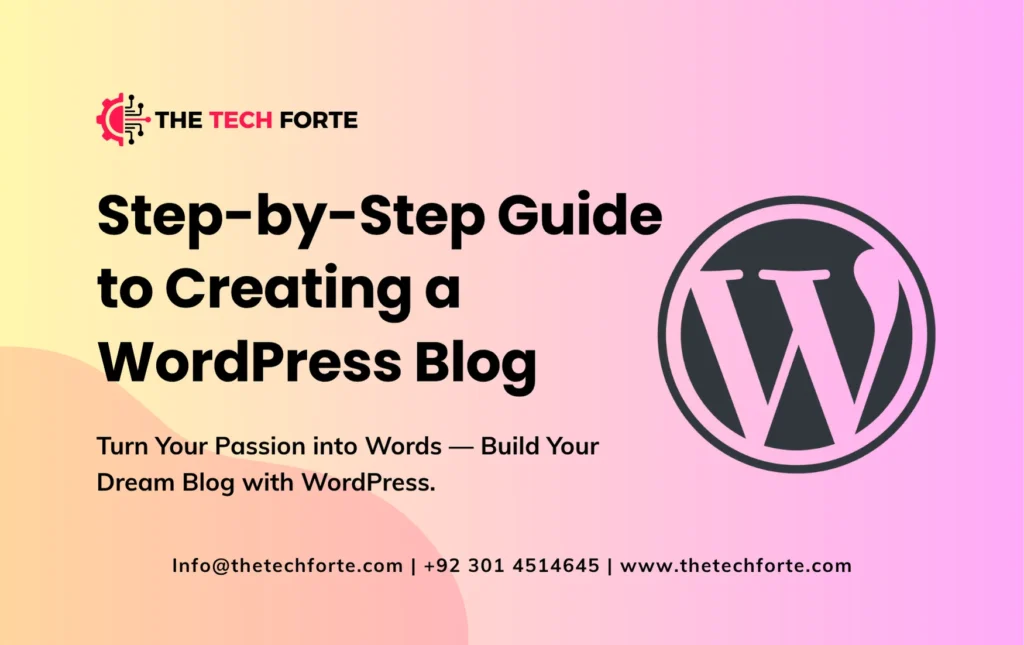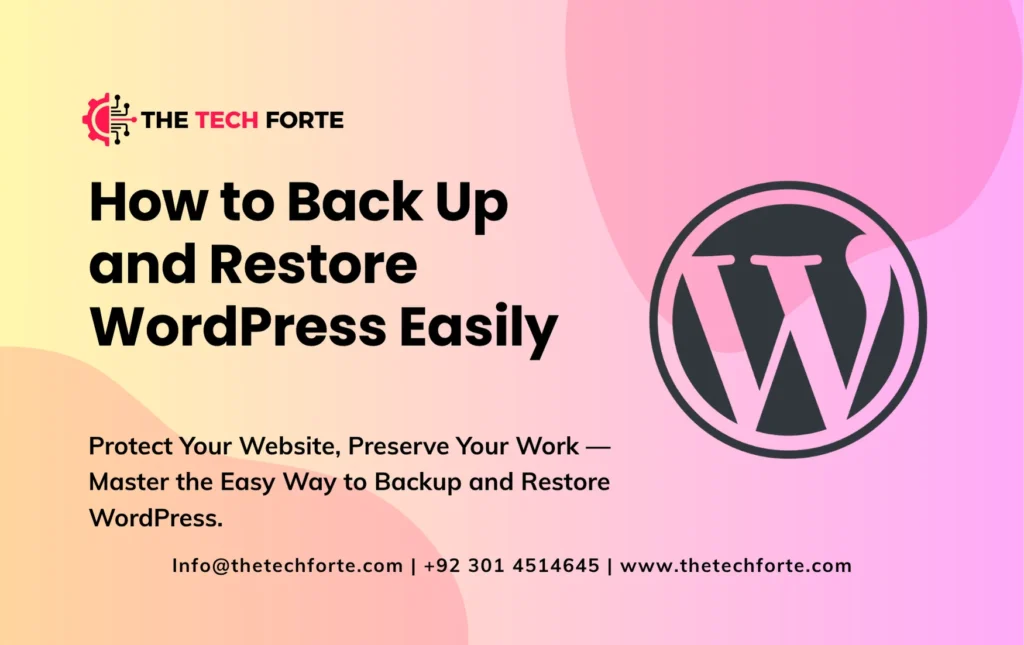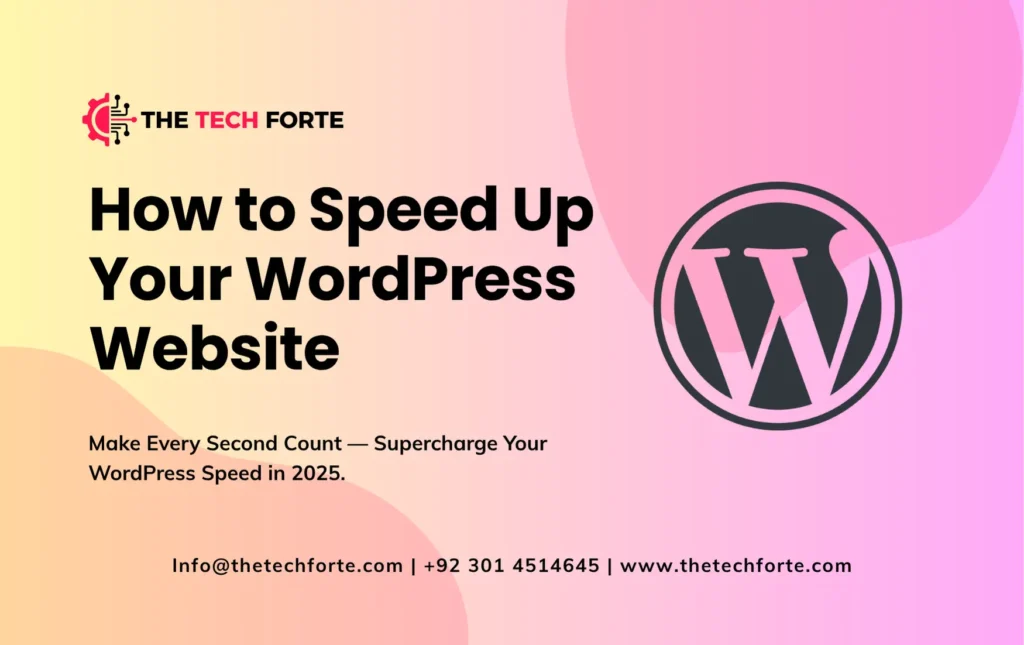How to Speed Up Your WordPress Website

In today’s fast-paced digital world, speed is everything. Whether you’re running a blog, e-commerce store, or business site, a slow-loading website can cost you visitors, conversions, and search rankings. The good news? You can easily speed up your WordPress website with the right optimization techniques.
This in-depth guide walks you through how to speed up your WordPress site step by step — covering caching, image optimization, database cleanup, and more. By the end, you’ll have a faster WordPress site, higher SEO rankings, and happier users.
Let’s dive into the best WordPress speed optimization strategies for 2025.
Read More: How to Speed Up WordPress Websites: 15 Proven Methods
Why WordPress Speed Matters in 2025
A fast website isn’t just a luxury — it’s essential. Studies show that if your page takes more than 3 seconds to load, most visitors leave. Moreover, Google uses page speed as a ranking factor, meaning a faster site can help you rank higher in search results.
A slow WordPress site can lead to:
- Higher bounce rates
- Lower SEO rankings
- Poor user experience
- Reduced conversions
By focusing on WordPress performance optimization, you can enhance user satisfaction and improve your site’s visibility in search engines.
How to Test Your WordPress Website Speed
Before making any changes, you need to measure your current performance. Use these tools to check your site’s loading time and find areas for improvement:
- Google PageSpeed Insights – Measures Core Web Vitals and gives actionable recommendations.
- GTmetrix – Provides detailed metrics like TTFB (Time to First Byte) and waterfall analysis.
- Pingdom – Excellent for tracking load times from multiple locations.
- WebPageTest – Offers insights on server response and rendering speed.
Record your scores and retest after every optimization to track improvements in WordPress performance metrics.
Choose the Best Hosting for WordPress Speed
Your hosting provider plays a major role in your site’s speed. Even the best optimization efforts won’t help if your hosting is slow.
Look for the fastest WordPress hosting providers 2025 that offer:
- SSD or NVMe storage for faster data retrieval.
- Built-in caching and CDN for quicker content delivery.
- Server locations near your audience to reduce latency.
- 24/7 uptime and support for reliability.
Popular fast hosts include SiteGround, Kinsta, WP Engine, and Hostinger. Investing in good hosting is the foundation of increasing WordPress website speed.
Use a WordPress Caching Plugin
Caching helps store static versions of your website, reducing the time it takes for your pages to load. When a user visits, they see the cached version instead of loading everything from scratch.
The best WordPress caching plugins for 2025 include:
- WP Rocket – Premium, all-in-one caching and optimization.
- W3 Total Cache – Free, feature-rich caching plugin.
- LiteSpeed Cache – Ideal for LiteSpeed servers.
- WP Super Cache – Lightweight and beginner-friendly.
Caching can reduce page load time in WordPress by over 50% — one of the easiest ways to make your WordPress site faster.
Optimize Your Images for Faster Loading – Speed Up Your WordPress Website
Images are often the biggest culprits behind slow websites. Optimizing them reduces file size without sacrificing quality.
To optimize WordPress images, follow these tips:
- Compress images using TinyPNG or ShortPixel.
- Convert formats to WebP or AVIF for smaller, faster images.
- Use lazy load images in WordPress to delay off-screen loading.
- Install plugins like Smush, Imagify, or EWWW Image Optimizer.
Properly optimized images can significantly reduce page load time in WordPress, boosting both speed and SEO performance.
Minify CSS, JavaScript, and HTML
Minification removes unnecessary code (like spaces and comments) from your site files, reducing their size and improving load times.
Plugins like Autoptimize, WP Rocket, or Asset CleanUp can minify CSS and JavaScript in WordPress automatically. You can also defer JavaScript loading so that scripts don’t block page rendering.
These small tweaks can lead to major improvements in WordPress performance optimization and Core Web Vitals scores.
Enable GZIP Compression
GZIP compression helps your server deliver compressed versions of your site’s files to browsers, reducing load times by up to 70%.
You can enable GZIP compression using plugins like WP Rocket or through your hosting control panel. Alternatively, you can add code to your .htaccess file if your host supports it.
This is a must-do step for anyone looking to increase WordPress website speed without changing content.
Optimize Your WordPress Database
Over time, your database fills with unnecessary data such as revisions, spam comments, and transients. Cleaning it regularly can improve WordPress performance and reduce server response time.
Use plugins like:
- WP-Optimize
- Advanced Database Cleaner
- WP Sweep
These tools remove clutter and help your site run more efficiently. Always back up your database before optimization!
Use a Content Delivery Network (CDN)
A CDN for WordPress stores your site’s static files (images, CSS, JS) across multiple servers around the globe. When someone visits your site, the nearest CDN server delivers the content — improving Speed Up Your WordPress Website dramatically.
Top CDN options include Cloudflare, BunnyCDN, and KeyCDN. Many hosts like Kinsta or WP Engine have CDNs built in.
A CDN not only reduces server response time but also improves WordPress mobile speed optimization for global audiences.
Reduce Server Response Time (TTFB)
TTFB (Time to First Byte) measures how long your server takes to respond. A lower TTFB means a faster site.
To improve TTFB:
- Use fast hosting and enable caching.
- Minimize plugins that overload your server.
- Use a CDN for static content.
- Optimize your database and PHP version.
Improving TTFB contributes directly to better Core Web Vitals and smoother user experiences.
Optimize for Core Web Vitals
In 2025, Core Web Vitals are more important than ever for SEO & Speed Up Your WordPress Website. These include:
- LCP (Largest Contentful Paint): Measures loading performance.
- FID (First Input Delay): Measures interactivity.
- CLS (Cumulative Layout Shift): Measures visual stability.
To improve them:
- Use lazy loading for images and videos.
- Optimize fonts and CSS delivery.
- Reduce JavaScript execution time.
Tools like PageSpeed Insights and Lighthouse help track your Core Web Vitals for WordPress.
Use Lightweight Themes and Plugins
Heavy themes with too many features slow down your site. Choose lightweight themes like Astra, GeneratePress, or Neve — optimized for speed and clean code.
Also, regularly audit your plugins. Deactivate or delete unnecessary ones and replace bulky plugins with lightweight alternatives.
This simple step can dramatically improve WordPress performance without advanced technical work.
Read More: Best WordPress Themes for 2025: Top Picks for Business, Blogging & eCommerce
Implement Lazy Loading for Videos and Media
Embedding YouTube or Vimeo videos can increase load times. Use lazy loading so videos only load when they’re about to be viewed.
Plugins like WP Rocket, Lazy Load by WP Rocket, or a3 Lazy Load can automate this.
This reduces initial page weight and improves mobile speed on WordPress, enhancing both UX and SEO.
WordPress Speed Optimization Tools You Should Use
Here are some essential tools for WordPress performance optimization in 2025:
- Google PageSpeed Insights – Core Web Vitals check.
- GTmetrix – In-depth performance analysis.
- Query Monitor – Detects slow plugins and database queries.
- Perfmatters – Lightweight optimization plugin.
- WP Rocket – Comprehensive caching and performance suite.
These tools help you identify and fix bottlenecks that slow down your site.
Common Mistakes That Slow Down WordPress Sites
Avoid these frequent speed-killers:
- Using shared or poor-quality hosting.
- Uploading large, uncompressed images.
- Running too many plugins.
- Ignoring caching and CDN setup.
- Failing to update WordPress and themes.
Avoiding these issues is crucial if you want to reduce WordPress load time to under 2 seconds and maintain high SEO performance.
FAQs – Speed Up Your WordPress Website
Why is my WordPress website so slow?
Large images, poor hosting, and excessive plugins are common causes.
What is the best way to speed up WordPress?
Use caching, optimize images, and choose fast hosting.
How do I optimize images in WordPress?
Use image compression tools or plugins like Smush or Imagify.
What are the best caching plugins for WordPress?
WP Rocket, LiteSpeed Cache, and W3 Total Cache are top choices.
Does website speed affect SEO?
Yes. Google considers page speed a ranking factor under Core Web Vitals.
How can I improve mobile speed on WordPress?
Use responsive themes, optimize media, and leverage AMP plugins.
Conclusion: Make Your WordPress Site Lightning Fast in 2025
Speed is no longer optional — it’s a ranking, user experience, and revenue factor. By applying these WordPress speed optimization techniques, you can:
- Reduce load times under 2 seconds
- Improve SEO rankings and conversions
- Deliver a smoother, mobile-friendly experience
In 2025, the websites that win aren’t just beautiful — they’re fast, responsive, and Speed Up Your WordPress Website.
So start today — compress, cache, and accelerate. The faster your site, the further your success will go.











































































































































































